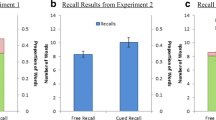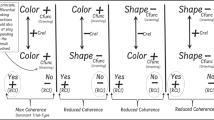The study reported here addressed the behavioral and EEG correlates of the effects of dual images used as primers for a lexical decision task to seek evidence for inhibition theory or episode retrieval theory as explanations of the negative priming effect. At the behavioral level, conscious meanings of dual images were found to produce positive priming effects, while unconscious meanings produced negative priming effects. EEG correlates of these effects were identified in the anterior-central regions of the brain. Thus, a decrease in the amplitude of the N400 component served as a correlate of positive priming, while a decrease in the amplitude of the late positive complex was a correlate of negative priming. Both components are considered in the literature as indicators of episode retrieval, a process associated with memory. The fact that the priming effect of unconscious meanings of dual images at the psychophysiological level is expressed in terms of memory phenomena leads to the conclusion that subjects remember meanings that they did not notice.
Similar content being viewed by others
References
Allakhverdov, V. M., Collected Essaysin, Vol. 7, The Mysterious Beauty of Consciousness: Conversations about Eternal Problems, or an Invitation to the Absurd, Vladimir Dal’, St. Petersburg (2021).
Bartholow, B. D., Pearson, M. A., Dickter, C. L., et al., “Strategic control and medial frontal negativity: Beyond errors and response conflict,” Psychophysiology, 42, No. 1, 33–42 (2005).
Behrendt, J., Gibbons, H., Schrobsdorff, H., et al., “Event-related brain potential correlates of identity negative priming from overlapping pictures,” Psychophysiology, 47, 921–930 (2010).
D’Angelo, M. C., Thomson, D. R., Tipper, S. P., and Milliken, B., “Negative priming 1985 to 2015: A measure of inhibition, the emergence of alternative accounts, and the multiple process challenge,” Q. J. Exp. Psychol., 69, 1890–1909 (2016).
Egner, T. and Hirsch, J., “Where memory meets attention: Neural substrates of negative priming, J. Cogn. Neurosci., 17, No. 11, 1774–1784 (2005).
Filippova, M. G. and Kostina, D. I., “Dynamics of priming-effect for subliminally presented ambiguous pictures,” J. Cogn. Psychol., 32, No. 2, 199–213 (2020).
Gibbons, H., “Functional brain-electrical correlates of negative priming in the flanker task: Evidence for episodic retrieval,” Psychophysiology, 46, No. 4, 807–817 (2009).
Heil, M. and Rolke, B., “Unattended distractor-induced priming in a visual selective attention task: N400 effects in the absence of RT effects,” J. Psychophysiol., 18, 164–169 (2004).
Hellerstedt, R. and Johansson, M., “Competitive semantic memory retrieval: Temporal dynamics revealed by event related potentials,” PLoS One, 11, No. 2, e0150091 (2016).
Kathmann, N., Bogdahn, B., and Endrass, T., “Event-related brain potential variations during location and identity negative priming,” Neurosci. Lett., 394, No. 1, 53–56 (2006).
Mayr, S., Niedeggen, M., Buchner, A., and Orgs, G., “The level of reaction time determines the ERP correlates of auditory negative priming,” J. Psychophysiol., 20, 186–194 (2006).
McLennan, K. S., Neumann, E., and Russell, P. N., “Positive and negative priming differences between short-term and long-term identity coding of word-specific attentional priorities,” Atten. Percept. Psychophys., 81, No. 5, 1426–1441 (2019).
Ngo, K. W. J., “Electrophysiological signature of suppression of competitors during interference resolution,” Brain Res., 1767, 147564 (2021).
Peterson, M. A., “Past experience and meaning affect object detection: A hierarchical Bayesian approach,” in: Psychology of Learning and Motivation – Advances in Research and Theory, Academic Press Inc. (2019), pp. 224–257.
Tal, A. and Bar, M., “The proactive brain and the fate of dead hypotheses,” Front. Comput. Neurosci., 8, No. 3, 1–6 (2014).
Tipper, S. P., “Does negative priming reflect inhibitory mechanism? A review and integration of conflicting views,” Q. J. Exp. Psychol., 54, No. 2, 321–343 (2001).
Wesslein, A.-K., Naumann, E., Spence, C., and Frings, C., “Modulations of event-related potentials by tactile negative priming,” NeuroReport, 30, No. 3, 227–231 (2019).
Yaple, Z. and Arsalidou, M., “Negative priming: a meta analysis of fMRI studies,” Exp. Brain Res., 235, No. 11, 3367–3374 (2017).
Author information
Authors and Affiliations
Corresponding author
Additional information
Translated from Zhurnal Vysshei Nervnoi Deyatel’nosti imeni I. P. Pavlova, Vol. 73, No. 3, pp. 348–356, May–June, 2023.
Rights and permissions
Springer Nature or its licensor (e.g. a society or other partner) holds exclusive rights to this article under a publishing agreement with the author(s) or other rightsholder(s); author self-archiving of the accepted manuscript version of this article is solely governed by the terms of such publishing agreement and applicable law.
About this article
Cite this article
Filippova, M.G., Chernov, R.V. & Gorbunov, I.A. Unnoticed but not Forgotten: EEG-Correlates of the Priming Effects of Dual Figures. Neurosci Behav Physi 53, 1435–1440 (2023). https://doi.org/10.1007/s11055-023-01536-z
Received:
Accepted:
Published:
Issue Date:
DOI: https://doi.org/10.1007/s11055-023-01536-z




